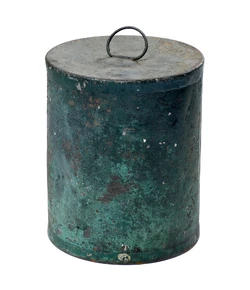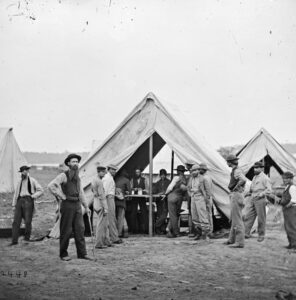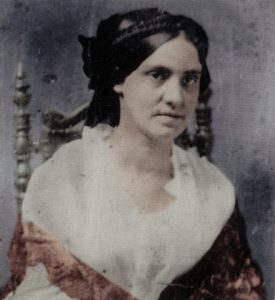Can It: Why Canned Foods Were Not Army Staples
Joseph Sherfy’s peach orchard is among the premier features of the Gettysburg battlefield and was witness to some of its most severe fighting. The produce from this location went to Sherfy’s nearby dried and canned fruits enterprise.[1] The process of preserving food in this manner was over 50 years old during the Civil War, yet canned goods were uncommon sights for the men in ranks. With spoiled rations being one of many components contributing to the noncombat deaths total, why were these products not widely used?
Englishman Peter Durand and Frenchman Nicholas Appert separately developed processes to preserve foodstuffs in 1810. Appert used glass containers, but Durand’s method of sealing the product in tin developed to become commercially viable in the U.S. within a decade. The New York City firm Daggett & Kensett marketed its wares to naval captains in 1822. After Daggett withdrew, Thomas Kensett & Co. saw lucrative growth from the Mexican War, Gold Rush, and Civil War, as they and their competitors grew their businesses thanks to the value of nonperishables to those on the move.[2]

When the war began, new firms sprung up in the North to manufacture canned goods to sell to sutlers, civilians who followed the army and sold items directly to its soldiers. Many startups, as was common in multiple industries, sold inferior products to increase their profits. It quickly became best practice to purchase from the few established factories. Almost one hundred varieties of tinned food were available for purchase in 1861.[3]
Even though the process was relatively novel, complaints as to the quality of this sustenance are virtually nonexistent. The remarkable shelf life and impermeability of cans during this period is attested to by the underwater archaeology of the Bertrand. This civilian sternwheeler ventured up the Missouri River bound for the mining town of Fort Benton in the Montana territory. On April 1, 1865, she snagged on a bend twenty-five miles north of Omaha, Nebraska, and sank.[4] In 1968, salvage teams recovered canned vegetables, oysters, and peaches, which the National Food Processors Association examined six years later. The researchers determined that although the nutritional value deteriorated, there was no outside contamination, and these foods were still safe to eat.[5]
Despite the value of preserving otherwise perishable food, canned goods were infrequent parts of a Civil War soldier’s diet. Rarely were they components of army-issued rations. One exception is reported by Pvt. William Ray on Independence Day 1864, as members of his 7th Wisconsin “got 4 cans of preserved turkey, beef & tomatoes & once before get Sourkraut &c. We live well now. Verry.”[6] The cost of these items seemed to be the factor inhibiting their widespread adoption.

Tenth Massachusetts Battery Pvt. John D. Billings wrote Hardtack & Coffee in 1881, perhaps the best primary source on camp life in the Army of the Potomac. Billings remembered canned food offered to the army by sutlers. “He had a line of canned goods which he sold mostly for use in officer’s messes. The canning of meats, fruits, and vegetables was then in its infancy, and the prices, which in time of peace were high, by the demands of war were so inflated that the highest of high privates could not aspire to sample them unless he was the child of wealthy parents who kept him supplied with a stock of scrip or greenbacks.”[7] Union soldiers more often encountered these staples in care packages from home. Whereas many comfort foods would spoil during transit, canned goods arrived unspoiled and ready to consume.[8]
Johnny Reb seldom received these items because of a lack of canning facilities and the runaway inflation in the Confederacy. Lieutenant John H. Worsham of the 21st Virginia recalled arriving at Manassas Junction on August 27, 1862, after a three-day march of sixty miles without food. The weary infantrymen soon found themselves in the land of plenty upon entering the previously Federal-controlled storehouses under orders to take four days of rations. “It was hard to decide what to take, some filled their haversacks with cakes, some with candy, others oranges, lemons, canned goods, etc.”[9]

The southern civilian market likewise suffered a dearth of tinned options. Lieutenant Colonel Thomas Livingston Bayne resided in Richmond with fellow officers from 1863 onward. He relied on Secretary of the Treasury George Trenholm to procure canned meats and other delicacies, such as coffee and sugar, from international sources.[10] After the capital’s fall to Federal forces, nurse Phoebe Pember remarked in her diary that Northern canned goods sellers “inundated Richmond with pictorial canisters at exorbitant prices, which no one had money to buy.”[11]
These accounts reveal that it was not the quality of canned goods that limited their application, as indeed, they were a delicacy. The prohibitive cost of these items, the relative lack of existing manufactories, and the difficulty of sourcing them in the Confederacy all contributed to their presence as a rare luxury rather than a staple during the Civil War.
————
[1] Allen C. Guelzo, Gettysburg: The Last Invasion (New York: Alfred A. Knopf, 2015), 304.
[2] Ruth Levitt, “Tin Cans and Patents,” Prologue: Quarterly Journal of the National Archives 45, no. 3/4 (2013): 61-65. https://www.archives.gov/files/publications/prologue/2013/fall-winter/patents.pdf.
[3] Gregg Steven Pearson, “The Democratization of Food: Tin Cans and the Growth of the American Food Processing Industry, 1810-1940,” PhD diss., (Lehigh University, 2016): 71-72. https://preserve.lehigh.edu/_flysystem/fedora/2023-11/preservebp-10369561.pdf.
[4] Jerome E. Petsche, “Uncovering the Steamboat Bertrand,” Nebraska History 51 (1970): 1-15. https://web.archive.org/web/20130522150801/http://www.nebraskahistory.org/publish/publicat/history/full-text/NH1970Bertrand.pdf.
[5] Dale Blumenthal, “The Canning Process; Old Preservation Technique Goes Modern,” FDA Consumer 24, no. 7 (1990): 14-18. https://quackwatch.org/wp-content/uploads/sites/33/quackwatch/casewatch/fda/fda_consumer/1990-september.pdf.
[6] William R. Ray, Four Years with the Iron Brigade: The Civil War Journals of William R Ray, Co. F, Seventh Wisconsin Infantry (New York: Hachette Books, 2002): 287.
[7] John D. Billings, Hardtack & Coffee: The Unwritten Story of Army Life (Lincoln: Bison Books, 1993): 224-225.
[8] Janet K. Jacobs, “Send More Butter’ Finding Meaning Civil War Food References,” PhD diss., (University of Texas at Dallas, 2021): 33.https://utd-ir.tdl.org/server/api/core/bitstreams/1bbe51ed-7256-40cb-bbc5-c7071c2aa971/content.
[9] John H. Worsham, One of Jackson’s Foot Cavalry: His Experience and What HE Saw During the War, 1861-1865, Including a History of “F Company,” Richmond, Va., 21st Regiment Virginia Infantry, Second Brigade, Jackson’s Division, Second Corps, A. N. Va. (Chapel Hill: Univeristy of North Carolina at Chapel Hill, 1998): 121.
[10] Thomas Livingston Bayne, “Life in Richmond, 1863-1865,” Confederate Veteran 30, (1922): 100.
[11] Phoebe Pember, A Southern Woman’s Story: Life in Confederate Richmond (New York: G.W. Carleton & Co., 1879): 137.
Very interesting. I especially like the story of how canned goods were still edible and safe after being underwater for six years.
Oliver Willcox Norton born in 1839.
Norton was a bugler during the Civil War and is credited with the first sounding sounding of Taps which took place during July 1862 at Harrison’s Landing VA, now Berkeley Plantation.
He led a remarkable life and went on to write about his experiences during the war in particular the action on Little Round Top on the 2nd day of Gettysburg. After the war he went on to become a millionaire in the canning business and supported the arts with his donations.
A true warrior, author, philanthropist and American.
You can read about him here:
http://tapsbugler.com/oliver-willcox-norton/
Thanks for sharing, Joe. I knew about him playing taps, but had no idea he lived this fascinating of a life. It’s very cool to learn how successful he became!
Oliver Willcox Norton, fought on Little Round Top, first bugler to play Taps
In 1870, Norton joined his younger brother, Edwin, in a manufacturing venture in Chicago. The firm prospered, and, in 1901, their company became a part American Can Company.